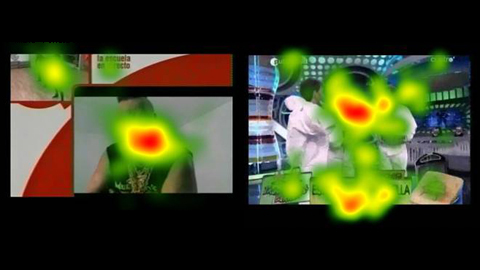Television advertising embedded in programmes shown to be ineffective in older adults

26/10/2015
This is the first study to examine how this group attend and process advertising that appears on screen without breaking the continuity of the programmes, compared to young viewers.
It is known that ageing affects basic executive cognitive functions such as memory, leading to slower processing of information and a gradual deterioration in the ability to organise it spontaneously. But until now no studies had shown to what extent older adults process television content, nor what happens at the cognitive level when programmes and unconventional advertising (UA) share the TV screen.
The researchers conducted the study with 30 young adults and 30 older adults, using eye tracker technology and questionnaires on content recognition and behaviour towards advertising content, in three UA contexts: screen sharing, overlay or banner (graphic advertising image at the bottom of the screen), and animation (usually the channel logo).
The results indicate that UA captures the attention of both older adults and young people, though the degree of attention paid depends on the intrusiveness of the advertising. During screen sharing, the adults pay more attention to the programme than the young people, but when the banner or the animation appears the visual attention of both groups is the same. When the banner is showing the advertising distracts attention completely from the programme, while during the animation both programme and advertising receive equal attention.
The researchers stress, however, that the greatest differences are in recognition of the TV content observed: the adults' spontaneous recognition of the UA being very much worse than that of the young people. Only 23% recognise the brand or product being advertised, compared to 88% in the case of young people. Furthermore, 61% of the adults, compared to 4% of the young people, show a blocking situation when having to recognise spontaneously the information they have just seen.
“Our results show that ageing does not affect the attention paid to embedded content so much as information processing skills. Older adults process UA on a pre-attention or unconscious level the same as young people, but unlike the latter they hardly ever get to identify and recognise it. Therefore this type of advertising is not effective in their case, because of the difficulty they have in processing and separating the relevant information – the programme – from the superfluous information – the advertising – although they don't confuse the two", explains Elena Añaños, from the Department of Advertising, Public Relations and Audiovisual Communication of the UAB, who directed the study.
The study also looked into the aversion that UA triggers in the individuals involved and channel-hopping behaviour. In the adults, the level of aversion is high, but lower than in the young people, which could be explained by the fact that the former process less advertising content. However, their behaviour when UA appears on screen is no different to the young people's: they ignore the advertising, keep on watching the programme and show no negative attitudes towards the channel or the advertiser.
“The results obtained are significant enough to consider adapting embedded TV content, especially UA, to older adults. If the aim is for them to not only notice this advertising – which they already do unconsciously – but also process it and remember the brand, the product, etc., it should be made larger and given more exposure time. Also, when the UA is being displayed the information appearing on screen should contain the minimum number of elements possible", points out Elena Añaños.
Reference: Añaños, E. (2015). EyeTracker Technology in Elderly People: How Integrated Television Content is Paid Attention to and Processed. Comunicar, 45, 75-83. DOI: http://dx.doi.org/10.3916/C45-2015-08
More information: http://gent.uab.cat/elenaananos/content/eye-tracking